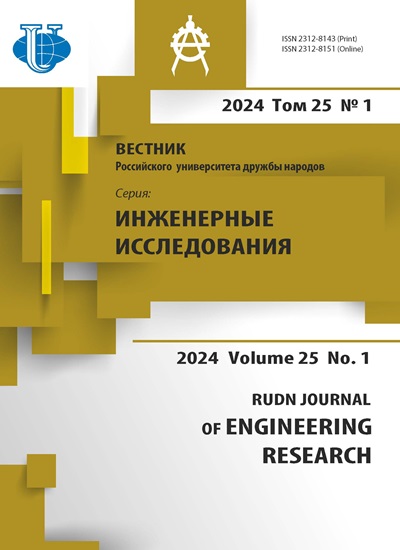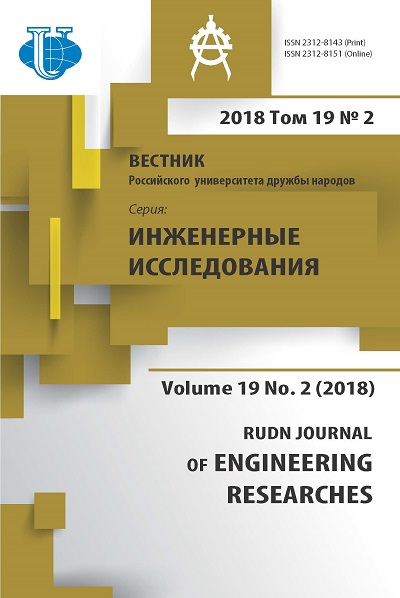DETERMINATION OF CONTACT STRESSES AND GAPS IN CHAIN TRANSMISSION HINGES
- Authors: Belousov Y.V1, Strashnov S.V2
-
Affiliations:
- Bauman Moscow State Technical University (National Research University of technology)
- Peoples’ Friendship University of Russia (RUDN University)
- Issue: Vol 19, No 2 (2018)
- Pages: 147-154
- Section: Mechanical engineering and power-plant
- URL: https://journals.rudn.ru/engineering-researches/article/view/18911
- DOI: https://doi.org/10.22363/2312-8143-2018-19-2-147-154
Cite item
Full Text
Abstract
The article considers the questions of determination of contact stresses in the chain transmission hinges that need to be known for assessing their wear resistance, because the wear and tear of hinges is the most common type of damage to the chain gears. In this context the main attention was paid to determining the required clearance between the bushing and the pin of roller chain drives. This gap largely determines the character of the distribution and magnitude of contact stresses in the hinge, and, consequently, the durability of chain drives. A method of calculation of the maximum contact stresses in the chain transmission hinges is developed. It is shown that decreasing clearance in the hinges increases the contact angle between the pin and the bushing and reduces the maximum contact pressure. However, for the actual angles of contact the contact stress greatly exceeds the allowable average unit pressure, causing increased wear of the hinges. One of the possible solutions to this problem is the use of transition fits in hinges, in which the gaps and interferences are relatively small. When pressing the pins into in the bushings, due to cutting microasperities from the contact surfaces, the interference in the connection virtually disappears. Examples of determining gaps and contact stresses in the chain transmission hinges are provided.
About the authors
Yury V Belousov
Bauman Moscow State Technical University (National Research University of technology)
Author for correspondence.
Email: belou.80@mail.ru
Candidate of Technical Sciences, Associate Professor, Department of Fundamentals of Machine Construction, Moscow State Technical University. Research interests: machine parts, mechanical engineering
5/1, 2-ya Baumanskaya str., Moscow, 105005, Russian FederationStanislav V Strashnov
Peoples’ Friendship University of Russia (RUDN University)
Email: shtrafnoy@gmail.com
Candidate of Technical Sciences, Senior lecturer, Department of Architecture and Construction, Peoples’ Friendship University of Russia. Research interests: machine parts, mechanical engineering
6, Miklukho-Maklaya str., Moscow, 117198, Russian FederationReferences
- Belousov Yu.V. Analysis conditions for reliable attach of workpieces during lathe machining on the mashines with numerical soft-ware control. RUDN Journal of Engineering Researches. 2017. Vol. 19. No. 1. P. 91—96. (in Russ.)
- Belousov Yu.V. Modelling of force interaction of the tool during mechanical machining. Structural mechanics of engineering constructions and buildings. 2016. No. 4. P. 62—66. (in Russ.)
- Kogaev V.P., Drozdov Yu.N. Prochnost’ i iznosostoikost’ detalei mashin [Strength and durability of machine parts]. Study guide for mechanical engineering higher education institutions. Moscow: Vysshaya Shkola Publ., 1991. 319 p. (in Russ.)
- Andrienko L.A., Baykov B.A., Zakharov M.N. etc. Detali mashin [Machine parts]. Textbook for universities / Under the editorship of O.A. Ryakhovsky. Moscow: Baumanpress Publ., 2014. 465 p. (in Russ.)
- Shambina S.L., Rekach F.V., Belousov Yu.V. On new modifications of some strength criteria for anisotropic materials. Key Engineering Materials. Vol. 724. 2016. P. 53—57. Smart Materials Technologies.
- Hoffman N.P., Stolz V. Ontransient growth of wear pattern properties. Wear. 2010. Vol. 268. No. 7-8. P. 886—892.
















